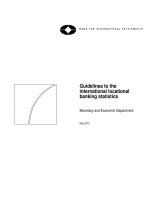Guidelines to advanced macro 2023
Bạn đang xem bản rút gọn của tài liệu. Xem và tải ngay bản đầy đủ của tài liệu tại đây (588.5 KB, 12 trang )
GUIDELINES TO
ADVANCED MACROECONOMICS
Notes, Legend and Model Descriptions
Krisztián KOPPÁNY
Széchenyi István University, Győr
1 KEYNESI KIADÁSI-JÖVEDELMI MULTIPLIKÁTOR MODELLEK
1.1 ONE-REGION KEYNESIAN MULTIPLIER MODELS
What do you know about John Maynard Keynes? Google him using the slide with
some keywords below!
John Maynard Keynes
(1883-1946)
Microversus
Macroeconomics
Great Depression
„But this long run is a misleading
guide to current affairs. In the
long run we are all dead.” A
Tract on Monetary Reform
(1923), Ch. 3, p. 80
Active
Government Policy
Multiplier,
Richard Kahn
Source: />12
Krisztián KOPPÁNY
John Maynard Keynes (1883-1946) is one of the greatest and most influential economists of the twentieth century. His thoughts fundamentally changed the way the economy works, especially the macroeconomy. In his work published in 1936, he formed an
economic model significantly different from the mainstream at the time. The global
economic crisis that broke out in 1929 played a major role in this, to the solution of
which the mainstream could not provide a meaningful answer.
Of course, there have been serious economic problems and market imbalances in
the past, but these have not caused much of a break and created a crossroads in the
development of economics. This is obviously also due to the level of development of
economics at that time. By the 1930s, however, our discipline already had a mature
micro-theory, the most important message of which was that economic automatisms
Krisztián KOPPÁNY
1
steer markets towards equilibrium, and this mechanism would sooner or later balance
all markets. The equilibrium is stable and general.
During the Great Depression, the above theorem seemed to be false, and even if
it was true in the long run, it must have failed in the short run, at the level of national
economic processes. Keynes said that “… long run is a misleading guide to current
affairs. In the long run we are all dead.” He tried to provide a corresponding solution
to the problems of the economy with insufficient demand. He called for the active
economic role of the state and the increase of government orders.
The multiplier is Keynes' theoretical tool. With this he demonstrates and calculates
the beneficial consequences of extra budget spending. The idea, by the way, was not
originally from Keynes, but from one of his students, his later colleague Richard Kahn.
To demonstrate the operation of the multiplier, first take a country with no foreign
economic relations or any other territorial unit smaller or larger. In the first step, therefore, we examine the closed economy of a single region.
1.1.1 Closed economy
Y
C
C(Y)
I
G
C0
ˆ
c
c
AS
or YS
AD
or YD
Yp
P
Ye
1
ˆ
1− c
Yield as Value Added
Macroeconomic Value Added = Gross Domestic Product (GDP)
Y = GDP
GDP form 3 approaches
Production approach: Y = Gross Output – Intermediate Consumption
(Intermediate Consumption: current use of raw materials, parts and components, and purchased services); Y = the value of final products
Income approach: Value Added becomes the income of primary resources
(Labour, Capital), Y = primary incomes
Expenditure approach (ex post): the value of final products equals the use of
them by households (consumption, C), business companies (investment, I),
and government (government spending, G)
Consumption
consumption as the function of macroeconomic income
Investment
Government spending
autonomous consumption
(hypothetical consumption in the case of zero income)
marginal propensity to consume, dC/dY
average propensity to consume or consumption rate C/Y
Aggregate Supply, final products supplied
Aggregate Demand, demand for final products as planned expenditures,
YD = C + I + G
potential GDP
Price level
equilibrium income or equilibrium GDP
simple Keynesian income-expenditure multiplier
Krisztián KOPPÁNY
2
Figure 1.1. Income-expenditure multiplier in the Keynesian cross
YD
YD = YS
YD’
E
YD
D
B
C
ΔG
A
ΔYe
45
Ye
Y
Ye’
P
AS
ΔYe
Ye
Ye’
Yp
Y
Y = C + I + G.
(1.1)
ˆ
C(Y) = C0 + cY
(1.2)
Substituting (1.2) to (1.1) yields
ˆ +I+G
Y = C0 + cY
(1− cˆ ) Y = C0 + I + G
Y=
1
( C + I + G) .
ˆ 0
1− c
ˆ to 0.75, the multiplier will be
If we set c
1
= 4.
1− 0.75
In Figure 1.1 the economy is in an initial equilibrium in point A, where effective demand
(YD) and the supply of final products (Y) (or income) are equal. An injection of extra
government spending (∆G) moves the demand curve to left up. In point B, the economy is in the state of excess demand. Having enough production capacity (as shown
in the bottom diagram, where actual GDP (Ye) is far from the full-capacity level (Yp,
potential GDP), where supply can adapt to demand easily without significant price
changes), production will grow to meet extra demand (see arrow form point B to C).
Increasing production generates extra incomes and extra consumption expenditures
Krisztián KOPPÁNY
3
(from C to D), and a situation with excess demand (although a little smaller than before) occurs again. The iteration process goes on until we reach the new equilibrium,
ˆ is
where the GDP is Ye’. The change in GDP (Ye’ - Ye) is higher (four times higher if c
0.75) than the initial change in government spending (∆G).
1.1.2 Open economy
With an open economy model one can easily show that the multiplier can be below
one, as well. This gives a better description of the Hungarian economy, which has become more and more integrated into the world economy and global value chains in
the last two and a half decades.
X
M
M(Y)
m
1
ˆ+m
1− c
Exports
Imports
imports as the function of macroeconomic income
import rate (in proportion to GDP)
Simple Keynesian income-expenditure multiplier for open economy
M+ Y = C + I + G + X
Y = C+ I + G+ X − M
(1.3)
Y =C+I+ X −M
(1.4)
C(Y) = cY
(1.5)
M(Y) = mY .
(1.6)
Substituting (1.5) and (1.6) to (1.4) yields
Y = cY + I + X − mY
(1− c + m) Y = I + X
Y=
1
(I + X )
1− c + m
1
= 0.952 .
1− 0.75 + 0.8
For a Hungarian case study using official statistical data from Central Statistical Office
of Hungary (see STADAT Table 3.1.7) see 3_1_7ie
DEFAULT.xls. The solution and the Excel formulas are shown in the screenshots below.
Increasing import rates decreased significantly the simple Keynesian income-expenditure multiplier in Hungary.
With setting c = 0.75 and m = 0.8 the multiplier will be
Krisztián KOPPÁNY
4
Krisztián KOPPÁNY
5
A Hungarian Case Study
1,8
1,6
1,4
1,2
1,0
0,8
0,6
0,4
0,2
Consumption rate
15
See 3_1_7i_KIINDULÓ.xls,
3_1_7ie DEFAULT.xls
Krisztián KOPPÁNY
2015
2013
2014
2012
2010
2011
2009
2007
Import rate
2008
2005
2006
2003
2004
2002
2000
2001
1999
1997
1998
1995
1996
0,0
GDP multiplier
Krisztián KOPPÁNY
6
1.2 MULTIREGION KEYNESIAN MULTIPLIER MODELS
1.2.1 Two-region model (EU-Hungary model)
subscipts
superscripts
row
s
the region that the variable (GDP, expenditure or share) belongs/refers
to
the destination or origin region of an expenditure flow
rest of the world
share variables express the regional distribution of an expenditure flow
subscripts: the variable that the share refers to
superscripts: the region that the share refers to
The GDP expenditure identity for Hungary and EU
Yhu = Chu + Ihu + Xhu − Mhu , and
(1.7)
Yeu = Ceu + Ieu + Xeu − Meu .
(1.8)
Chu = chuYhu
(1.9)
Ceu = ceuYeu
(1.10)
eu
row
Xhu = Xhu
+ Xhu
(1.11)
hu
row
Xeu = Xeu
+ Xeu
(1.12)
eu
row
Mhu = Mhu
+ Mhu
(1.13)
hu
row
Meu = Meu
+ Meu
(1.14)
Mhu = mhuYhu
(1.15)
Meu = meuYeu
(1.16)
eu
row
sM
+ sM
=1
hu
hu
hu
row
sM
+ sM
=1
eu
eu
eu
row
Mhu = sM
mhuYhu + sM
mhuYhu
hu
hu
(1.17)
hu
row
Meu = sM
meuYeu + sM
meuYeu
eu
eu
(1.18)
hu
eu
Xeu
= sM
mhuYhu
hu
(1.19)
eu
hu
Xhu
= sM
meuYeu
eu
(1.20)
hu
row
Yhu = chuYhu + Ihu + sM
meuYeu + Xhu
− mhuYhu
eu
row
hu
Yhu = Ihu + Xhu
+ ( chu − mhu ) Yhu + sM
meuYeu
eu
Krisztián KOPPÁNY
(1.21)
7
row
hu
Yhu − ( chu − mhu ) Yhu = Ihu + Xhu
+ sM
meuYeu
eu
(1− chu + mhu ) Yhu = Ihu + Xhurow + sMhu meuYeu
eu
Yhu =
1
row
hu
I + Xhu
+ sM
meuYeu
eu
1− chu + mhu hu
(
)
(1.22)
eu
row
Yeu = ceuYeu + Ieu + sM
mhuYhu + Xeu
− meuYeu
hu
row
eu
Yeu = Ieu + Xeu
+ sM
mhuYhu + ( ceu − meu ) Yeu
hu
(1.23)
…
Yeu =
1
row
eu
I + Xeu
+ sM
mhuYhu
hu
1− ceu + meu eu
(
row
chu − mhu
Yhu Ihu + Xhu
+ eu
=
row
Yeu Ieu + Xeu sMhu mhu
)
hu
sM
meu Yhu
eu
ceu − meu Yeu
(1.24)
(1.25)
Y = o + OY
(1.26)
(E − O) Y = o
(1.27)
Y = (E − O ) o = Ro
(1.28)
−1
r
r
R = 1,1 1,2
r2,1 r2,2
Y1(hu) = r1,1o1 + r1,2o2 ,
Y2(eu) = r2,1o1 + r2,2o2 ,
ri , j =
dYi
.
doj
Each ri,,j is a multiplier which expresses the change in country i's GDP caused by 1 unit
change in country j’s exogenous variables (investments and exports to the row).
EQUATION CHAPTER (NEXT) SECTION 1
Krisztián KOPPÁNY
8
2. INPUT-OUTPUT TABLES AND MODELS
The following table shows the general structure of an input-output table and the notations for the main parts of it.
billion HUF
(unless indicated otherwise)
Agriculture
I ndustry
Serv ices
I mports
Gross Value Added
of which labour incomes
Total Input
Number of employees
(thousand people)
Emission of greenhouse gas
(thousand tons)
Z
f
x
im’
va’
hi’
x’
em’
gh’
Agriculture
I ndustry
Z
Serv ices
Final
demand
Total Output
f
x
im'
va'
hi'
x'
em'
gh'
the square matrix of the intersectoral transactions (intermediate consumption of the domestic industries that comes from the home economy)
column vector of the final demand (or final use) for (of) sectoral output
column vector of total sectoral output
row vector of the import purchases of the domestic production sectors (intermediate consumption of the domestic industries that comes from
abroad)
row vector of sectoral value added (GDP at basic prices produced in
each industry)
row vector of sectoral household income (labour incomes paid to employees in each industry)
row vector of total sectoral input (the transpose of output vector x, the
output and the input of a sector is always the same, two sides of the same
coin)
row vector of sectoral employment (number of employees in each industry)
row vector of sectoral greenhouse gas emission
Next diagram shows the direction of causation in the demand-driven (pull) Leontief
input-output model. Values of the final demand for sectoral products are the exogenous variables, which pull the whole economy’s performance. In the basic setting
there are no capacity constraints, so any demand can be satisfied. To do this, companies in each sector must purchase inputs from other companies from the same or
different industries (domestic intermediate consumption), from abroad (imports), and
they need primary inputs (labour and capital) as well, for which they must pay. The
labour and capital income are the value added.
The demand for intermediate products generates more and more production rounds
in the economy. This multiplicative process results in a higher value of production, imports, value added, employment and greenhouse gas emission than it follows directly from the final demand impulse. The total magnitude of the direct and indirect
effects is involved and measured by the so-called Type 1 multipliers. Type 1 multipliers
Krisztián KOPPÁNY
9
pertain to the open input-output model, where all final demand is exogenous, see
the table below. For the illustration of the direction of causation see arrows.
billion HUF
(unless indicated otherwise)
Agriculture
Agriculture
I ndustry
Serv ices
I mports
Gross Value Added
of which labour incomes
Total Input
Number of employees
(thousand people)
Emission of greenhouse gas
(thousand tons)
I ndustry
Serv ices
462
315
231
273
819
420
2,100
530
3,710
2,650
12,720
6,890
3,180
26,500
265
1,855
6,095
3,445
14,840
9,275
26,500
288
1,170
2,543
7,510
37,940
10,270
Final
Total Output
demand
843
2,100
20,620
26,500
17,524
26,500
The model can be formalized and solved as follows.
Input coefficients for intermediate purchases from other domestic industries (matrix A
of direct technical coefficients or direct domestic requirements), imports (m’), value
added (v’), household incomes (h’), and employment (e’) and greenhouse gas (g’)
intensities can be obtained by dividing the corresponding value of the IO table by
the column sums (i.e. the total input), or, using matrix operations, by multiplying the
corresponding matrix or vector by x
−1
, which is the inverse of the diagonal output
matrix.
A=
m' =
v' =
h' =
e' =
g' =
Krisztián KOPPÁNY
Agriculture
0.2200
0.1500
0.1100
0.1300
0.3900
0.2000
0.1371
3.5762
I ndustry
0.0200
0.1400
0.1000
0.4800
0.2600
0.1200
0.0442
1.4317
Serv ices
0.0100
0.0700
0.2300
0.1300
0.5600
0.3500
0.0960
0.3875
A=Z x
−1
−1
m = im' x
−1
v = va x
−1
h = hi x
−1
e = em x
−1
g = gh x
10
The basic equations and the solution of Leontief’s demand-driven IO model for output (and the other variables) can be obtained are the following.
Z x
−1
x+f=x
im = m Lf
Ax + f = x
va = v Lf
f = x - Ax = (I - A) x
(I – A) f = (I – A)
−1
−1
hi = h Lf
(I - A) x
em = e Lf
(I – A) f = x
−1
L = (I – A)
−1
gh = g Lf
x = Lf
Lf = x
The Type 2 input-output model is closed to the households. In this case household
consumption vector of the final demand is an endogenous variable in the model,
and the values of it depend on labour incomes. Extra labour incomes will result in a
higher consumption, and this will launch a secondary multiplication process in the
model. As a result, we will have higher multiplier values for a narrow exogenous final
demand base. Type 2 final demand multipliers of the (still exogenous) other final use
(or final demand) are generally higher than their Type 1 equivalents.
Next table and diagram show the direction of causation in the Type 2 IO model
(closed to households).
billion HUF
(unless indicated otherwise)
Agriculture
I ndustry
Serv ices
I mports
Gross Value Added
of which labour incomes
Total Input
Number of employees (thousand
people)
Emission of greenhouse gas
(thousand tons)
Agriculture
I ndustry
Serv ices
462
315
231
273
819
420
2,100
530
3,710
2,650
12,720
6,890
3,180
26,500
265
1,855
6,095
3,445
14,840
9,275
26,500
288
1,170
2,543
7,510
37,940
10,270
Households'
Other final use Total Output
consumption
300
543
2,100
2,000
18,620
26,500
7,000
10,524
26,500
3,575
4,925
24,938
19,620
With Type 1 and 2 models we can calculate Type 1 and 2 final demand multipliers.
Type 1 multipliers involve only the direct and indirect effects through the upstream
value chains (primary multiplication circle). Type 2 multipliers also incorporate the socalled induced effects of a secondary multiplication process by the extra household
consumption paid from extra labour incomes.
Multipliers can be expressed for each endogenous variable of the model, for example for output, import, value added, labour income, employment and GHG emission.
The following table shows some examples for the Type 1 multipliers.
Krisztián KOPPÁNY
11
Output multiplier
I mport multiplier
Value added multiplier
Labour income multiplier
Employment multiplier
(thousand people/billion HUF)
Air pollution (GHG) multiplier
(thousand tons/billion HUF)
Agriculture
1.7498
0.3124
0.6876
0.3629
I ndustry
1.3716
0.5918
0.4082
0.2035
Serv ices
1.4461
0.2267
0.7733
0.4778
0.2085
0.0718
0.1339
5.0483
1.8681
0.7387
Here come some explanations for some values of the table.
Final demand output multiplier for Industry. 1-unit change in the exogenous components of the final demand for industrial products causes 1.3716-unit change in the
gross output (value of production) of the whole economy.
Final demand import multiplier for Services.1-unit change in the exogenous components of the final demand for services causes 0.2267-unit change in the imports of the
whole economy.
Final demand value added multiplier for Agriculture.1-unit change in the exogenous
components of the final demand for agricultural products causes 0.6876-unit change
in the value added of the whole economy.
…
Krisztián KOPPÁNY
12









